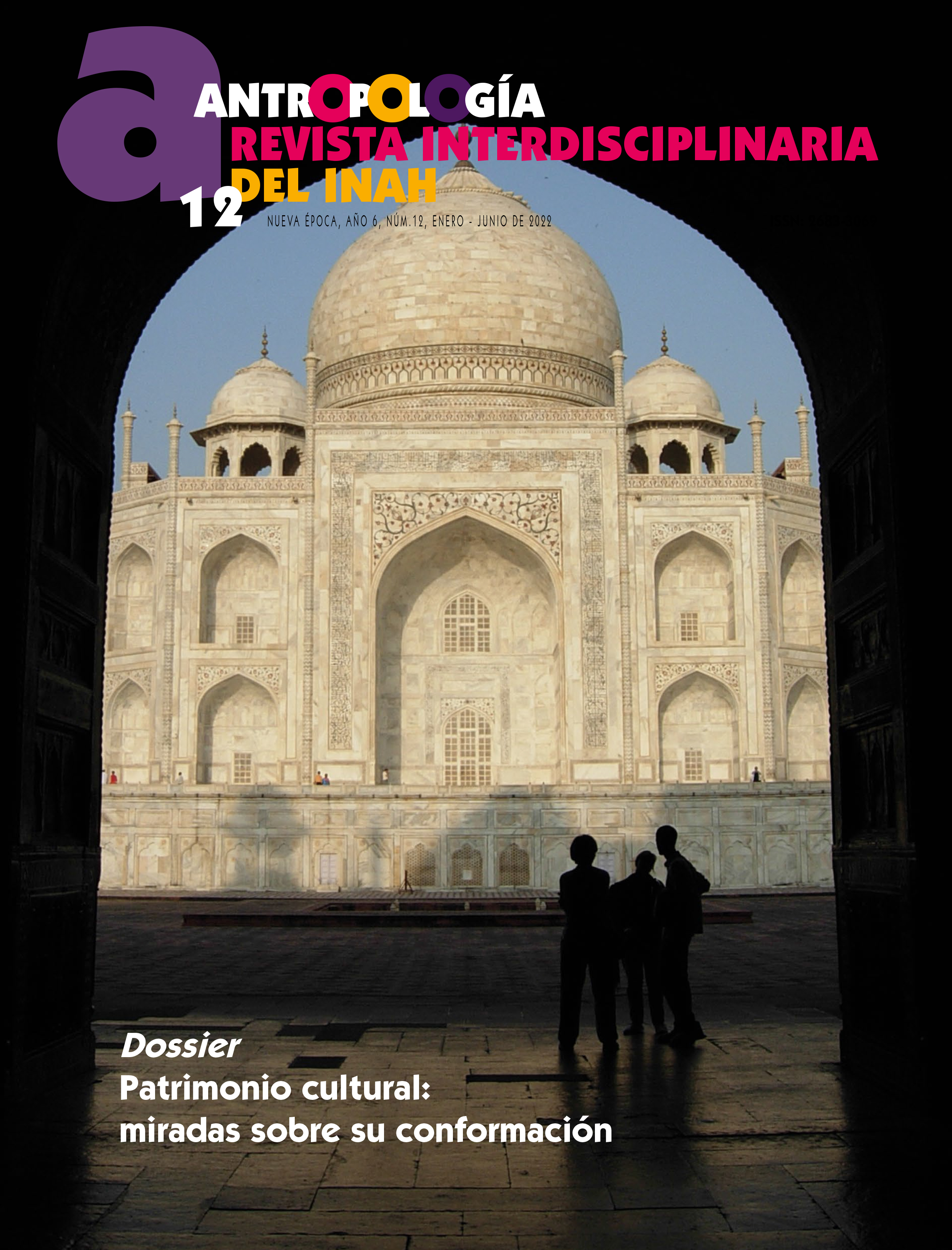Explorar las nociones de patrimonio en la India desde la perspectiva del hinduismo
Palabras clave:
patrimonio, tradición, paisaje, conservación, continuidad, material, inmaterial, conocimientos tradicionales.Resumen
El artículo reflexiona sobre las nociones de patrimonio basadas en las tradiciones filosóficas arraigadas en el hinduismo, la religión predominante en la India. El patrimonio (Virasat) se considera independiente de la tradición (Parampara). El documento delibera sobre las nociones espacial, temporal y experiencial del patrimonio. Mientras que el espacio se manifiesta a través de representaciones simbólicas a nivel macro y micro, el patrimonio tangible se crea y recrea a través de nociones cíclicas del tiempo, dando así al proceso un significado cultural mucho más amplio que al producto. La dimensión experiencial contribuye a vincular lo tangible y lo intangible en diversos modos de comprensión, por lo que la materialidad tiene una importancia mucho menor que la espiritualidad del patrimonio. Esta interpretación también tiene implicaciones para el enfoque tradicional de la conservación del patrimonio, que hace hincapié en todos los rituales vinculados a la regeneración de un patrimonio concreto, en contraste con la mera conservación de las ruinas “muertas”. El documento se detiene además en los principales retos a los que se enfrenta este patrimonio cuando se considera de forma estática y con una creciente desconexión entre lo tangible y lo intangible. El fracaso de los enfoques de conservación “occidentales” centrados en la preservación material nos ha hecho reflexionar sobre el enfoque del patrimonio vivo para la conservación, que aboga por permitir la continuidad y la evolución y controlar el cambio para proteger la esencia del patrimonio que está profundamente conectado con el ser.
Descargas
Citas
CHAPAGAIN, Neel Kamal (2013), “Contents and concerns in Asian heritage management”, en Kapila D. SILVA y Neel Kamal CHAPAGAIN (eds.), Asian Heritage Management, Kindle, Routledge.
DAGENS, Bruno (2017), Mayamata: An Indian Treatise on Housing Architecture and Iconography, 2a. ed., Nueva Delhi, New Age Books.
ELIADE, Mircea (1991), The Sacred and the Profane, Princeton, Princeton University Press.
GALTUNG, Johan (1979), Methodology and Development, Nueva York, Harper.
GASTNER, Theodor H. (1954), “Myth and Story”, Numen, vol. 1, núm. 1, pp. 184-212.
GUPTA, Divay (2003), “Three types of landscape”, Unpublished Paper.
HEEHS, Peter (ed.) (2002), Indian Religions: A Historical Reader of Spiritual Expression and Experience, Londres, C. Hurst & Co.
JIGYASU, Rohit (2005), “Disaster: A ‘Reality’ or Construct? Perspectives from the ‘East’”, en Ronald W. PERRY Y Enrico L. QUARANTELLI (eds.), What Is a Disaster? New Answers to Old Questions, Bloomington, Xlibris, pp. 49-59.
_____ (2013), “Using traditional knowledge systems for post-disaster reconstruction – Issues and challenges following Gujarat and Kashmir Earthquakes”, Creative Space, vol. 1, núm. 1, pp. 1-17.
KAWATHEKAR, Vishakha (2020), Legal Frameworks for the Protection of Built Heritage in India, Nueva Delhi, Copal Publishing Group.
LABADI, Sophia (2010), “World heritage, authenticity and post-authenticity”, en Sophia LABADI y Colin LONG (eds.), Heritage and Globalization, Londres, Routledge, pp. 66-84.
LEVY, Robert I., y Kedar Raj RAJOPADHYAYA (1991), Mesocosm: Hinduism and the Organization of a Traditional Newar City in Nepal, Berkeley, Oxford, University of California Press.
LOWENTHAL, David (2003), The Heritage Crusade and the Spoils of History, Cambridge, Cambridge University Press.
LUXEN, Jean-Louis 2004), “Reflextions on the Use of Heritage Charters and Conventions”, Conservation: Getty Conservation Institute Newsletter, vol. 19, núm. 2, pp. 4-9.
MALIK, Subhash Chandra (1990), Modern Civilization: A Crisis of Fragmentation, Nueva Delhi, Abhinav Publications.
_____ (1995), Reconceptualising the Sciences and the Humanities: An Integral Approach, Nueva Delhi, Manohar Publishers.
MASON, David V. (2009), Theatre and Religion on Krishna’s Stage: Performing in Vrindavan, Nueva York, Palgrave Macmillan.
MEHROTRA, Rahul (2008), “Negotiating the Kinetic and Static Cities: The Emergent Urbanism of Mumbai”, en Andreas HUYSSEN (ed.), Other Cities, Other World: Urban Imaginaries in a Globalizing Age, Durham / Londres, Duke University Press, pp. 205-218.
POULIOS, Ioannis (2012) “Discussing strategy in heritage conservation. Living heritage approach as an example of strategic innovation”, Journal of Cultural Heritage Management and Sustainable Development, vol. 4, núm. 1, pp. 16-34.
SAVYASAACHI (2017), “What Is Worthy of Conservation”, en Hriday Reflections, Ahmedabad, ICOMOS India, CEPT, pp. 27-30.
SENGUPTA, Nirmal (2007), “Introduction”, en Nirmal SENGUPTA (ed.), Economic Studies of Indigenous and Traditional Knowledge, Nueva Delhi, Academic Foundation, pp. 21-30.
SILLITOE, Paul (2006), “Introduction: Indigenous knowledge in development”, Anthropology in Action, vol. 13, núm. 3, pp. 1-12 <https://doi.org/10.3167/aia.2006.130302>, consultada el 10 de noviembre de 2021.
SINGH, Rana P. B., y S. Rana PARVEEN (2016), “Kashi and Cosmos: Spatial Manifestation and the Five Pilgrimage Journeys of Banaras”, International Journal of Religious Tourism and Pilgrimage, vol. 4, núm. 6, pp. 1-15 <https://doi.org/:https://doi.org/10.21427/D75Q7N>, consultada el 10 de noviembre de 2021.
SINGH, Rana P.B. (1993), “Cosmic layout of hindus sacred city, Varanasi”, Architecture and Compartment/Architecture and Behaviour (Association de La Revue) Special Issue: Lay-out of Scared Places, vol. 9, núm. 2, pp. 239-249.
SINHA, Amita (2020), Cultural Landscapes of India: Imagined, Enacted and Reclaimed. Cultural Landscapes of India: Imagined, Enacted and Reclaimed, Pittsburgh, University of Pittsburgh Press.
SMITH, Laurajane (2006), “The uses of heritage”, Public History Readings. <https://edisciplinas.usp.br/pluginfile.
php/2946833/mod_resource/content/1/uses of heritage Laurajane Smith.pdf>, consultada el 10 de noviembre de 2021.
TEUTONICO, Jeanne Marie, y Frank MATERO (2003) Managing change: sustainable approaches to the conservation of the built environment, Los Ángeles, Getty Conservation Institute.
THAPAR, Romila (1987), “Cultural Transactions and Early India: Patronage”, Social Scientist, vol. 15, núm. 2, pp. 3-31.
TOM, Binumol (2013), “Jiirnnoddharana. The Hindu philosophy of conservation”, en Kapila D. SILVA y Neel Kamal CHAPAGAIN (eds.), Asian Heritage Management Contexts, Concerns, and Prospects, New York, Routledge / Taylor & Francis, pp. 35-48.
UNESCO (2014), UNESCO culture for development indicators: Methodology Manual, París, UNESCO.
VATSAYAN, Kapila (1994), Concepts of Space: Ancient and Modern, New Delhi, Abhinav Publications.




